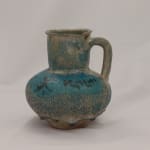Kashan Turquoise-Blue Glazed Jug, Thirteenth Century AD
Stonepaste, Pigment
height 14 cm
height 5 1/2 in
height 5 1/2 in
LI.3204
Further images
A unique jug with rounded bulbous body, plain handle, and cylindrical neck standing on a small unglazed foot, covered with a turquoise glaze. The piece is in very good conditions,...
A unique jug with rounded bulbous body, plain handle, and cylindrical neck standing on a small unglazed foot, covered with a turquoise glaze. The piece is in very good conditions, it is intact with only a very light iridescence. Interestingly, the jug presents a black paint inscription in Hebrew as well as the Arabic letter "noon", suggesting that it was probably made by Persians for the Jewish market and making this jug a unique and mysterious piece. This might also indicate that Jewish and Islamic culture sometimes shared artistic motifs and tastes, of which the present piece is a stunning example. The decoration of the jug is of a very high quality, not only providing evidence of the skills of the artisan who manufactured it but also suggesting that this jug was not for common use but was a more prestigious item. This type of ceramic vessel was mainly used for water or wine, and they often have one or even two handles.
After creating the ceramic body, the Islamic potter started to add colour, here, copper for turquoise. In a lead glaze copper turns green, but in the alkaline glazes it turns turquoise, and it is this turquoise which has been the signature mark of Persian ceramics and tiled domes ever since its introduction in the eleventh – twelfth century.
From between the eighth and eighteenth centuries, the use of glazed ceramics was prevalent in Islamic art, usually assuming the form of elaborate pottery.
Jugs of comparable shape and style were mainly manufactured in Iran in the 12th-14th centuries. The town of Kashan, as a city associated with high-quality ceramic production in the medieval period, became a distinct point of scholarly attention in the twentieth century. It appears to have been a major site for the manufacture of fine wares between the 1170s and 1220s as well as in the later 13th and early 14th centuries. The association between premodern Kashan and ceramic production is attested in the use of terms derived from the site’s name (kāši/kāšāni, or qāši/qāšāni) as the general designation for glazed tilework in Arabic and Persian sources.
After creating the ceramic body, the Islamic potter started to add colour, here, copper for turquoise. In a lead glaze copper turns green, but in the alkaline glazes it turns turquoise, and it is this turquoise which has been the signature mark of Persian ceramics and tiled domes ever since its introduction in the eleventh – twelfth century.
From between the eighth and eighteenth centuries, the use of glazed ceramics was prevalent in Islamic art, usually assuming the form of elaborate pottery.
Jugs of comparable shape and style were mainly manufactured in Iran in the 12th-14th centuries. The town of Kashan, as a city associated with high-quality ceramic production in the medieval period, became a distinct point of scholarly attention in the twentieth century. It appears to have been a major site for the manufacture of fine wares between the 1170s and 1220s as well as in the later 13th and early 14th centuries. The association between premodern Kashan and ceramic production is attested in the use of terms derived from the site’s name (kāši/kāšāni, or qāši/qāšāni) as the general designation for glazed tilework in Arabic and Persian sources.





